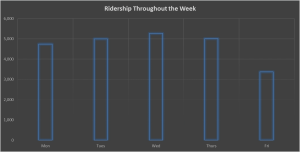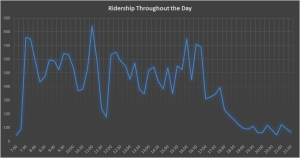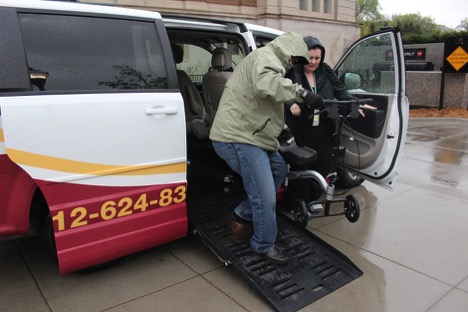Martina Jensen, a junior studying psychology, said the University of Minnesota’s Paratransit Service is essential for getting to classes. Because she uses both a wheelchair and a walker, getting around can be tiring, especially on such a big campus.
“It doesn’t help that sometimes I only have 15 minutes to get where I need to go,” Jensen said. “That’s why I appreciate paratransit so much.”
Like Jensen, those who take advantage of paratransit rides around campus appreciate the quality of the service, although they do see room for improvements in ride reservations, ride availability and awareness of the program.
The University of Minnesota service provides curb-to-curb rides for those with both short- and long-term disabilities. With pick-up and drop-off locations at every campus building, rides can be scheduled from 7 a.m. to 10 p.m. with any of its three vans.
Those vans, operated by Parking & Transportation Services, are available free of charge to all University students, faculty and staff, for a wide variety of reasons—from mobility disabilities to short-term injuries.
Funded from the Parking and Transportation Services’ parking revenue, the service cost the university around $238,000 to operate last year.
The vans average a combined total of 48 rides per day, with 923 rides this April alone.
Paratransit ridership has grown over the last few years. In 2016, 7,100 rides were given out, an increase of 22 percent over the previous year.

Riders reserve their van spots in advance online or over the phone for same-day accommodations. Jensen said she mostly stays on top of making her ride reservations, especially in the winter when snow, ice and cold make it harder to get around.
When she does forget, she said the same-day phone call system needs some improvements. Communicating her full information with the people who answer the phones can prove troublesome due to call clarity issues. Often needing to repeat herself, this can sometimes take up to 10 minutes just for one ride.
Paratransit driver Chad Hallada said riders also sometimes can’t get rides at certain high-volume times with vans are fully reserved, especially during the morning and evening commutes.

So, many riders say they try to schedule around peaks and adjust their reservations when time slots are unavailable.
Hallada thinks an updated reservation system could solve those problems. Similar to Uber cabs, benefits like on-demand ride requests, location-based reservations to the closest drivers and ride sharing could make paratransit more efficient for anyone who needs a ride.
Many think paratransit rides are only for those who have long-term motor disabilities. Hallada said it’s the opposite
“Most of our rides are reserved by athletes or students with injuries,” he said, although many temporarily injured people still balk at calling a van because they fear they’re taking rides away from other people.
Currently, the program is advertised in the Minnesota Daily and Campus Brief, and information is available at the Disability Resource Center and Boynton.
The latter is how Oluwadamilola Oyenekan found out about it. A second-year student studying bioproducts and biosystems engineering, Oyenekan still had pain from ankle surgery and needed a less painful way to get around..
Although she can see where increased advertising could bring a problem of too much use and demand, Oyenekan doesn’t believe anyone would abuse the system and that increased awareness would only help people.
“I didn’t know about it until I literally couldn’t move,” Oyenekan said. “I will see people on scooters or in chairs now, and I don’t know why they wouldn’t just take paratransit.”
This is what Paratransit is, but see it in action in our photo essay.

